AT2020sum-AT2020sun
On September 6, 2020, the MASTER team issued a warning after discovering two supernova candidates: AT2020sun and AT2020sum.
Two days later, and taking advantage of the fact that I could have them in the same field, I decided to focus on them to start following them up and try to determine what they were or whether or not it was a false positive.
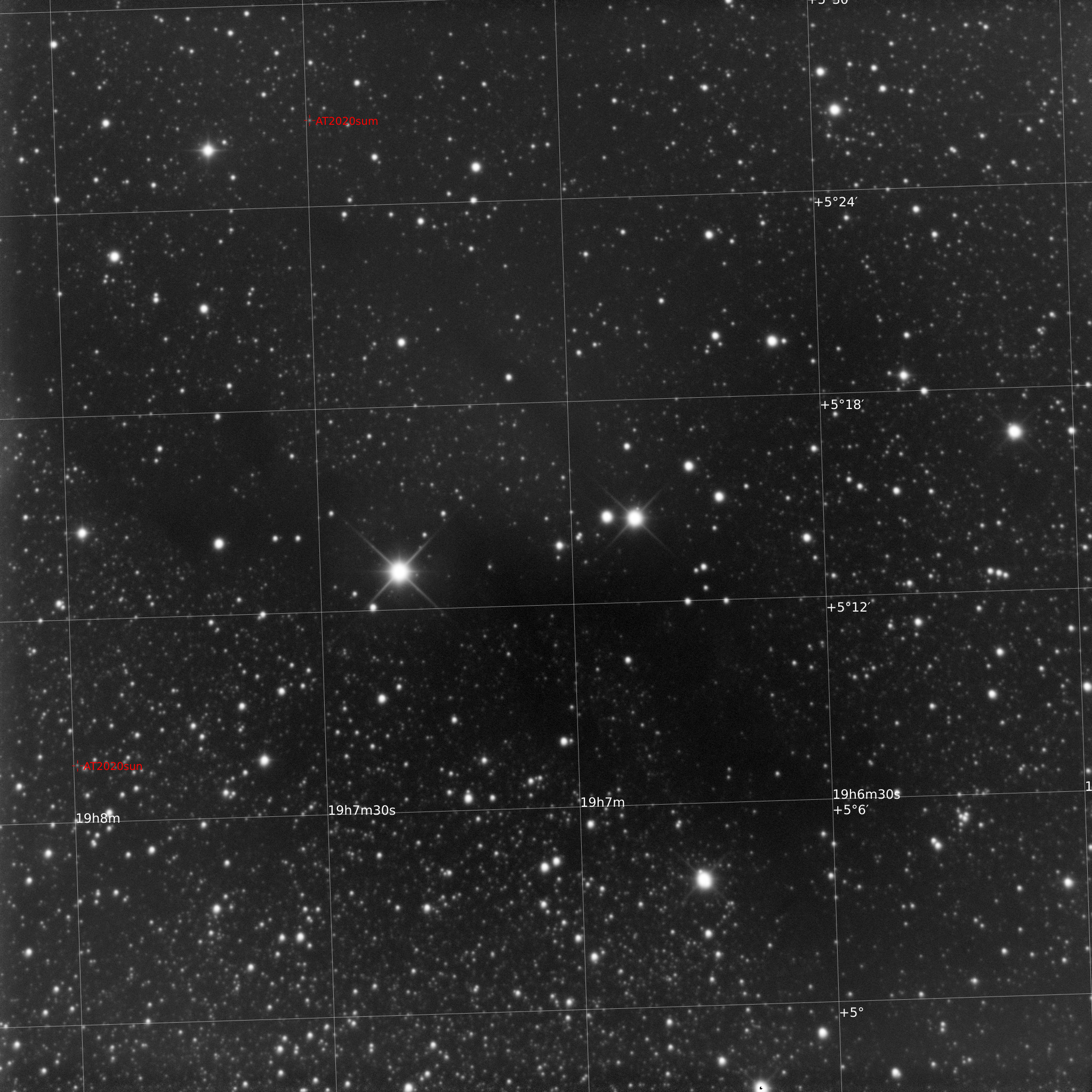
As we can see, it is a very beautiful area, full of stars, in the middle of the Milky Way. In the image we can clearly observe some nebular zones together with other dark ones, possibly generated by interstellar dust.
AT2020sum-sun](data/works/supernovas/AT2020sum-AT2020sun/2020sum_center.png)
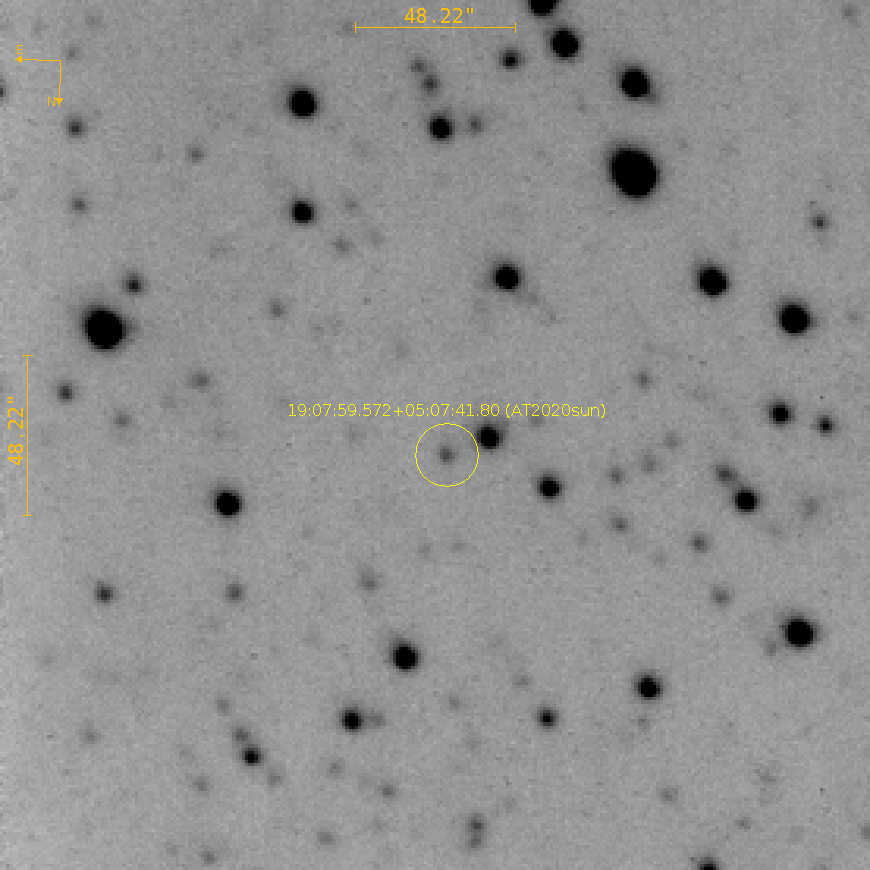
Apparently, nothing strange, in the coordinates of the two notices we find two stars, both with practically the same magnitude of 16.6.
But scratching a little, interesting points begin to emerge. As far as we can see, they are very red objects, which we confirm after consulting both PanSTARSS and DSS, 2MASS and IRAC images:
In the case of DSS, nothing appears in those positions in visible, but we can clearly see them in infrared, for example, in 2MASS (AT2020sun in SIMBAD/DSS and AT2020sum in SIMBAD/DSS):
 .
.

Although it is at the ASASSN limit, after consulting data for the last 1500 nights... nothing clear, lots of noise, except for four positive measurements with a ~1.5 mag jump between two of them in a short time for 2020sun. However, with respect to 2020sum.... only one from two years ago, where it seems to have been captured.
Regarding the photometric analysis, we can see that AT2020sun is having a brightness decrease, slow but stable, alternating with slight rises, but with a clear trend.
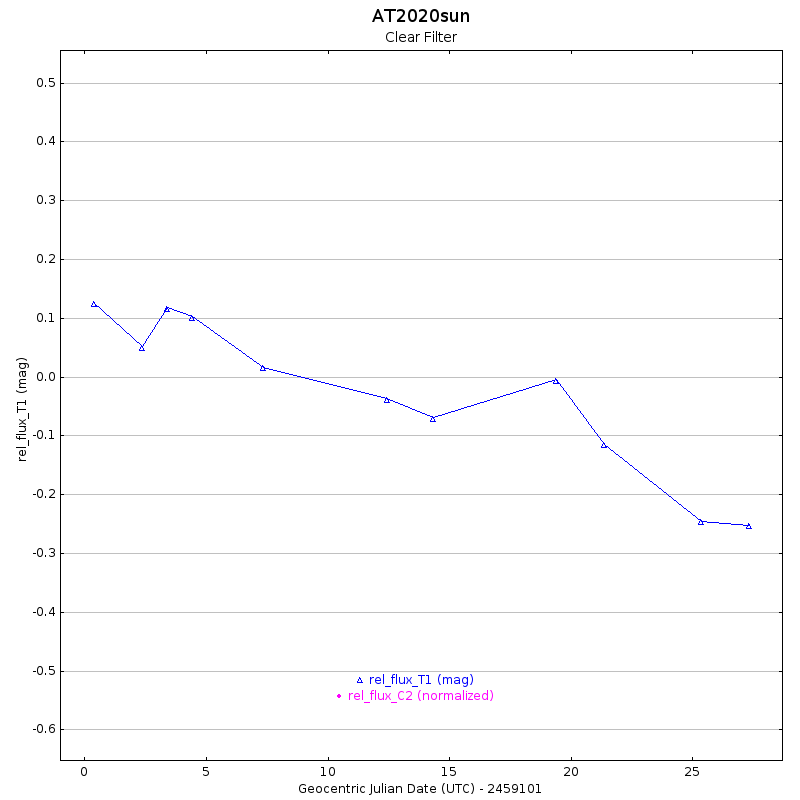
AT2020sum started out having a bit of a roller coaster behavior, although, in the visible spectrum, it is already getting lower in brightness, even more intense and almost linear in the last few days:
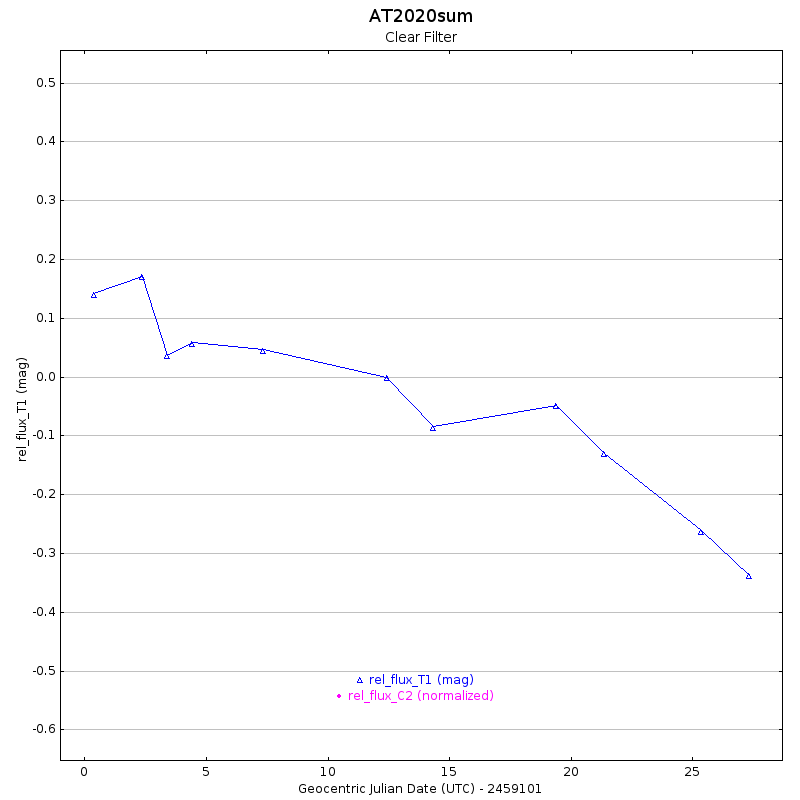
Being such red objects, I have started to follow them in the near infrared (>742nm), if we analyze it, after some rebound during the first days, they have a clear downward trend.

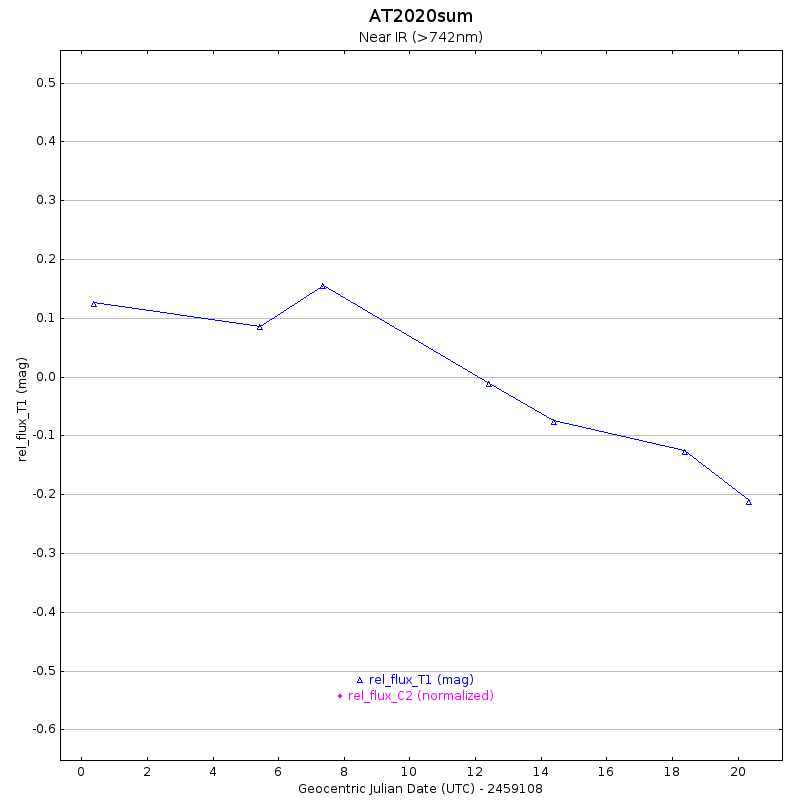
Hypothesis? Well none clear, at the moment, initially it could be:
- Mira variables, very cool red giants that normally emit most of the radiation in the infrared and that, in this case, have had some kind of peak that reaches the visible.
- Cataclysmic variables, although seeing the evolution they are having, it seems they are not going that way.
- Novae or supernovae? It could be, perhaps today it seems to me a more possible option than at the beginning.
We will follow their evolution to try to clarify the mystery.
I would like to thank the team of supernova observers and especially Juan-Luis Gonzalez for his help in the extraction of ASASSN data.
One year later
More than one year later, on October 7, 2021, we have revisited them... and the surprise has been important; I really did not expect to find anything, but yes, there they are both, practically maintaining their magnitude and even increasing it slightly, as in the case of AT2020sum.
Analysis
AT2020sum
Comp. stars
| Name | RA (J2000) | DEC (J2000) | Mag. (G) | Type |
|---|---|---|---|---|
| AT2020sum | 19:07:29.59 | 05:26:33.50 | -- | Target |
| 430 554 724 787 147 033 6 | 19:07:32.58 | 05:26:34.10 | 16.880 | C2 |
| 430 554 724 787 146 905 6 | 19:07:31.84 | 05:26:15.94 | 17.222 | C3 |
Photometry - Clear
| Date | Magnitude | Filter |
|---|---|---|
| 2020/09/08.853 | 16,557 | C (Clear) |
| 2020/09/10.860 | 16,527 | C (Clear) |
| 2020/09/11.898 | 16,662 | C (Clear) |
| 2020/09/12.929 | 16,641 | C (Clear) |
| 2020/09/15.843 | 16,653 | C (Clear) |
| 2020/09/20.911 | 16,699 | C (Clear) |
| 2020/09/22.834 | 16,783 | C (Clear) |
| 2020/09/27.895 | 16,746 | C (Clear) |
| 2020/09/29.857 | 16,828 | C (Clear) |
| 2020/09/03.856 | 16,960 | C (Clear) |
| 2020/09/05.825 | 17,035 | C (Clear) |
| 2021/10/07.850 | 17,491 | C (Clear) |
Photometry - NIR
| Date | Magnitude | Filter |
|---|---|---|
| 2020/09/15.869 | 16,259 | NIR (>742nm) |
| 2020/09/20.934 | 16,299 | NIR (>742nm) |
| 2020/09/22.852 | 16,229 | NIR (>742nm) |
| 2020/09/27.895 | 16.395 | NIR (>742nm) |
| 2020/09/29.857 | 16.459 | NIR (>742nm) |
| 2020/09/03.856 | 16.510 | NIR (>742nm) |
| 2020/09/05.825 | 16.595 | NIR (>742nm) |
Catálogo: Gaia GR2 (band G)
More info:
-
Radios fotométricos usados en AIJ:
Object Inner Outer 4 9 13
AT2020sun
Comp. stars
| Name | RA (J2000) | DEC (J2000) | Mag. (G) | Type |
|---|---|---|---|---|
| AT2020sun | 19:07:59.54 | 05:07:40.90 | -- | Target |
| 430 545 787 818 990 220 8 | 19:08:06.385 | 05:08:27.27 | 16.200 | C2 |
| 430 545 808 004 047 910 4 | 19:07:54.926 | 05:09:21.81 | 17.239 | C3 |
Photometry - Clear
| Date | Magnitude | Filter |
|---|---|---|
| 2020/09/08.853 | 16,625 | C (Clear) |
| 2020/09/10.860 | 16,700 | C (Clear) |
| 2020/09/11.898 | 16,634 | C (Clear) |
| 2020/09/12.929 | 16,649 | C (Clear) |
| 2020/09/15.843 | 16,735 | C (Clear) |
| 2020/09/20.911 | 16,788 | C (Clear) |
| 2020/09/22.834 | 16,821 | C (Clear) |
| 2020/09/27.895 | 16.755 | C (Clear) |
| 2020/09/29.857 | 16.865 | C (Clear) |
| 2020/09/03.856 | 16.996 | C (Clear) |
| 2020/09/05.825 | 17.003 | C (Clear) |
| 2021/10/07.850 | 17,171 | C (Clear) |
Photometry - NIR
| Date | Magnitude | Filter |
|---|---|---|
| 2020/09/15.869 | 15,684 | NIR (>742nm) |
| 2020/09/20.934 | 15,814 | NIR (>742nm) |
| 2020/09/20.852 | 15,792 | NIR (>742nm) |
| 2020/09/27.895 | 15.821 | NIR (>742nm) |
| 2020/09/29.857 | 15.860 | NIR (>742nm) |
| 2020/09/03.856 | 15.928 | NIR (>742nm) |
| 2020/09/05.825 | 15.976 | NIR (>742nm) |
Catálogo: Gaia GR2 (band G)
More info:
-
Radios fotométricos usados en AIJ:
Object Inner Outer 4 7 10

